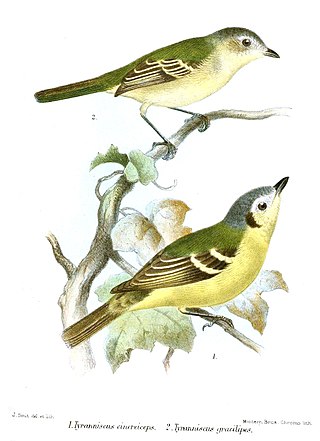
The black-faced antthrush is a species of passerine bird in the family Formicariidae. It is found in Central America from Honduras through Panama, on Trinidad, and in every mainland South American country except Argentina, Chile, Paraguay, and Uruguay.

The barred antshrike is a passerine bird in subfamily Thamnophilinae of family Thamnophilidae, the "typical antbirds". It is found in the Neotropics in Mexico, every country in Central America, Trinidad and Tobago, and every mainland South American country except Chile and Uruguay. There is also one accepted record from southern Texas.

The southern beardless tyrannulet is a small passerine bird in subfamily Elaeniinae of family Tyrannidae, the tyrant flycatchers. It is found in Costa Rica, Panama, in every mainland South American country except Chile, and on Trinidad.

The crested guan is a Near Threatened species in an ancient group of birds of the family Cracidae, which are related to the Australasian megapodes or mound builders (Megapodiidae). It is found from central Mexico through Central America and in Colombia, Ecuador, Peru, and Venezuela.

The torrent tyrannulet is a small bird in the family Tyrannidae, the tyrant flycatchers. It is found in Bolivia, Colombia, Costa Rica, Ecuador, Panama, Peru, and Venezuela.

The slaty antwren is a small passerine bird in subfamily Thamnophilinae of family Thamnophilidae, the "typical antbirds". It is found from Mexico south through Central America, Colombia, Ecuador, Peru, and Venezuela.

The yellow tyrannulet is a small passerine bird in subfamily Elaeniinae of family Tyrannidae, the tyrant flycatchers. It is found in Costa Rica, Nicaragua, Panama, and in every mainland South American country except Chile and Uruguay.

The speckled chachalaca is a species of bird in the family Cracidae, the chachalacas, guans, and curassows. It is found in Bolivia, Brazil, Colombia, Ecuador, and Peru.

The rufous-breasted antthrush is a species of bird in the family Formicariidae. It is found in Colombia, Costa Rica, Ecuador, Panama, Peru, and Venezuela.

The scaled antpitta is a species of bird in the family Grallariidae. It is found in Bolivia, Brazil, Colombia, Costa Rica, Ecuador, El Salvador, Guatemala, Guyana, Honduras, Mexico, Nicaragua, Panama, Peru, Trinidad and Tobago, and Venezuela.

The white-throated tyrannulet is a species of bird in subfamily Elaeniinae of family Tyrannidae, the tyrant flycatchers. It is found in Argentina, Bolivia, Brazil, Colombia, Ecuador, Peru, and Venezuela.

The Ecuadorian tyrannulet is a species of bird in the family Tyrannidae, the tyrant flycatchers. It is found in Colombia, Ecuador and Peru.

The marble-faced bristle tyrant is a species of passerine bird in the family Tyrannidae, the tyrant flycatchers. It is found in Bolivia, Colombia, Ecuador, Peru, and Venezuela.

The grey-throated leaftosser is a Near Threatened species of bird in the subfamily Sclerurinae, the leaftossers and miners, of the ovenbird family Furnariidae. It is found in Bolivia, Brazil, Colombia, Costa Rica, Ecuador, Panama, Peru, Trinidad and Tobago, and Venezuela.

The rufous-rumped antwren is a species of bird in subfamily Euchrepomidinae of family Thamnophilidae, the "typical antbirds". It is found in Colombia, Costa Rica, Ecuador, French Guiana, Guyana, Panama, Peru, Suriname, and Venezuela.

The black-crowned antshrike is a species of bird in subfamily Thamnophilinae of family Thamnophilidae, the "typical antbirds". It is found in every Central American country except El Salvador and in Colombia, Ecuador, Peru, and Venezuela.

The yellow-crowned tyrannulet is a species of bird in subfamily Elaeniinae of family Tyrannidae, the tyrant flycatchers. It is found in Costa Rica, Panama, and in every mainland South American country except Argentina, Chile, Paraguay, and Uruguay.

The slender-footed tyrannulet is a species of bird in the family Tyrannidae, the tyrant flycatchers. It is found in Bolivia, Brazil, Colombia, Ecuador, Peru, and Venezuela.

The white-fronted tyrannulet is a species of bird in subfamily Elaeniinae of family Tyrannidae, the tyrant flycatchers. It is found in Bolivia, Colombia, Costa Rica, Ecuador, Panama, Peru, and Venezuela.

The northern mouse-colored tyrannulet is a species of bird in subfamily Elaeniinae of family Tyrannidae, the tyrant flycatchers. It is found in Colombia, Costa Rica, Ecuador, Guyana, Panama, Trinidad, Venezuela, and possibly Brazil, French Guiana, and Suriname.























